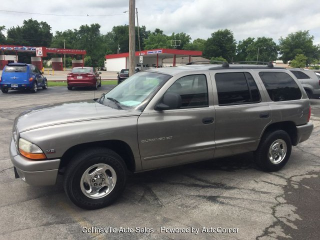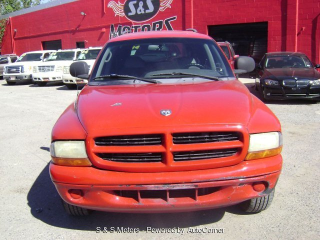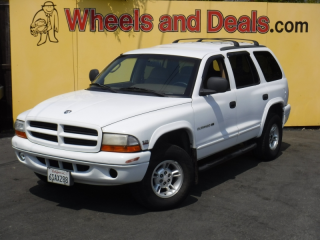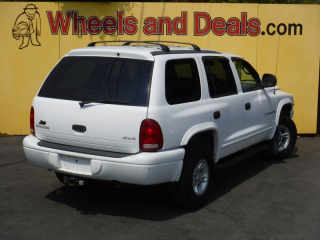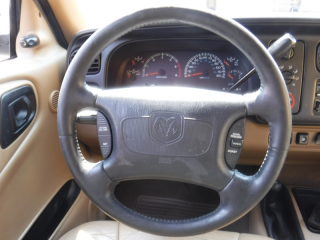The Good
The 1999 Dodge Durango offered strong performance thanks to its available V8 engines, providing ample power for towing and hauling, satisfying practical buyers. Its spacious interior and comfortable ride, especially on longer trips, appealed to families. The bold, muscular design exuded a sense of capability and adventure, resonating with emotional buyers looking for a commanding presence and utility vehicle that can handle a lot.
The Bad
Known weaknesses for the 1999 Dodge Durango include a propensity for transmission issues, particularly with the 46RE automatic. Electrical problems, such as faulty gauges or power accessories, are also common. Rust can be a significant concern, especially on the frame and body panels. Fuel economy is notably poor, and the brakes often wear quickly, requiring frequent maintenance.
1999 Dodge Durango: Quick Overview
Here's a bullet-point summary of key specifications for the 1999 Dodge Durango:
- Engine Options:
- 3.9L "Magnum" V6 (standard on 2WD models)
- 5.2L "Magnum" V8 (optional)
- 5.9L "Magnum" V8 (optional, most powerful)
- Horsepower:
- 3.9L V6: Approximately 175 hp @ 4800 rpm
- 5.2L V8: Approximately 230 hp @ 4400 rpm
- 5.9L V8: Approximately 245 hp @ 4000 rpm
- Torque:
- 3.9L V6: 225 lb-ft @ 3200 rpm
- 5.2L V8: 300 lb-ft @ 3200 rpm
- 5.9L V8: 335 lb-ft @ 3200 rpm
- Fuel Economy (Estimated City/Highway MPG):
- 3.9L V6 (2WD): ~14/19 MPG
- 5.2L V8 (2WD/4WD): ~12-13/16-17 MPG
- 5.9L V8 (2WD/4WD): ~11-12/15-16 MPG
- 0-60 MPH Times (Estimated):
- 5.2L V8: ~8.0-9.0 seconds
- 5.9L V8: ~7.5-8.5 seconds (considerably quick for its class and era)
- Towing Capacity (Maximum, when properly equipped):
- Up to 7,400 lbs (with 5.9L V8 and appropriate towing package)
- Trim-Level Features (Common across trims like Sport, SLT, SLT Plus):
- Sport: More basic, often cloth interior, manual windows/locks (though power options were available). Aimed at utility.
- SLT: Added features like power windows, power locks, air conditioning, cruise control, tilt steering, alloy wheels, and improved interior trim.
- SLT Plus: Top trim, typically included leather seating, premium sound system, overhead console, keyless entry, fog lamps, and other convenience/luxury items. Optional third-row seating was common across higher trims.
- Standard features across all trims included power steering, power brakes, and a multi-link coil spring rear suspension for a relatively smooth ride.
1999 Dodge Durango Specifications
Vehicle Information
| Year | 1999 |
| Make | Dodge |
| Model | Durango |
| Trim | - |
| Style | 2WD |
| Type | Sport Utility Vehicle |
| Category | Standard Sport Utility Vehicle |
Manufacturing Details
| Made In | United States |
| Manufacturing City | NEWARK |
Dimensions
| Doors | 4-Door |
| Curb Weight | 4413 pounds |
| Gross Vehicle Weight Rating | 6050 pounds |
| Overall Height | 71.00 inches |
| Overall Length | 193.30 inches |
| Overall Width | 71.50 inches |
| Wheelbase Length | 115.90 inches |
| Standard Seating | 5 |
Engine & Performance
| Engine | 5.9-L V-8 OHV 16V |
| Engine Size | 5.9L |
| Engine Cylinders | 8 |
| Transmission | 4-Speed Automatic |
| Transmission Type | Automatic |
| Transmission Speeds | 4-Speed |
| Drivetrain | Rear-Wheel Drive |
Additional Features
| Anti-Brake System | 2-Wheel ABS |
| Steering Type | Rack & Pinion |
Pricing
| Manufacturer Suggested Retail Price (MSRP) | $26,055 |
| Invoice Price | $23,528 |
| Delivery Charges | - |
Vehicle History Report
Specifications
History
Events
History Check
Check
Check
Check
Check
Listings
Recalls
Check
Analysis
What Problems Does the 1999 Dodge Durango Have?
Brake components, particularly rotors and pads, tend to wear quickly, leading to pulsation and reduced stopping power. This is exacerbated by the vehicle's weight and towing capabilities. Steering components, such as the steering pump and gear box, can also develop leaks or excessive play over time, impacting handling. Exhaust manifolds are known to crack, resulting in noisy engine operation and potential exhaust leaks.
Regarding recalls, the 1999 Durango was part of several, including one related to potential steering shaft separation (NHTSA Recall 98V065000), which could lead to loss of steering control. Another recall (NHTSA Recall 04V280000) addressed issues with the power steering hose potentially leaking and causing a fire. Additionally, airbags were subject to recalls (e.g., NHTSA Recall 00V300000) for issues with the inflator module. It's crucial for potential buyers to verify that all applicable recalls have been addressed. Rust is also a significant long-term concern, particularly in regions with road salt, affecting frame integrity and body panels. Engine sensors (e.g., Crankshaft Position Sensor, Oxygen Sensors) can fail, leading to rough idling or stalling.
How long will the 1999 Dodge Durango last?
What Technology & Safety Features are Included?
Built-in Tech & Entertainment:
- Audio System: Standard AM/FM stereo with cassette player was common, with optional CD player or changer available. Higher trims (SLT Plus) often included premium sound systems with multiple speakers.
- Convenience Features: Power windows, power door locks, power mirrors, and cruise control were widely available, standard on higher trims. Keyless entry was an optional or standard feature on SLT/SLT Plus models.
- Climate Control: Manual air conditioning and heating were standard, with rear auxiliary air conditioning available, particularly useful for the third row.
- Driver Information: A basic instrument cluster included speedometer, tachometer, fuel gauge, and temperature gauge. An overhead console might offer features like a compass and outside temperature display on upper trims.
- Airbags: Dual front airbags (driver and passenger side) were standard. Side airbags were not yet common in this vehicle class in 1999.
- Brakes: Four-wheel anti-lock brakes (ABS) were typically optional on most models and standard on some higher trims. Power front disc and rear drum brakes were standard.
- Lighting: Daytime Running Lights (DRLs) were available. Fog lamps were optional on SLT and standard on SLT Plus.
- Security: An engine immobilizer system and remote keyless entry could be equipped to deter theft.
- Child Safety: Rear child safety door locks were standard.
Crash test ratings for older vehicles like the 1999 Durango are less comprehensive than modern standards. The National Highway Traffic Safety Administration (NHTSA) conducted tests, with results typically as follows:
- Frontal Crash: Often received 3 out of 5 stars for the driver and 3 out of 5 stars for the front passenger.
- Side Impact: Ratings were generally not published as extensively for this model year or often showed 3 out of 5 stars.
- Rollover: Rollover resistance ratings were introduced later or were limited. Given its high center of gravity, like most SUVs of its time, rollover risk was a consideration.
What Colors Options are Available?
1999 Dodge Durango Prices and Market Value
In today's used market, prices for a 1999 Dodge Durango vary significantly based on condition, mileage, engine, and trim level. A fair condition model might fetch anywhere from $2,000 to $5,000. Exceptionally well-preserved, low-mileage examples, especially with the desirable 5.9L V8, could occasionally command slightly higher prices, perhaps up to $7,000-$9,000, though these are rare.
Depreciation has been substantial, as is typical for most mass-produced vehicles of this age. The Durango has long since reached the bottom of its depreciation curve. Factors affecting its current resale value include the overall mechanical condition, presence of rust, working status of all electronics, and proper maintenance history. Models with known transmission issues or significant rust will be on the lower end, while those with a clean title and good service records will hold slightly more value. The 5.9L V8 engine, known for its power, often makes a Durango more desirable to enthusiasts or those needing its towing capability, slightly bolstering its value.
1999 Dodge Durango Cost of Ownership
- Insurance: Typically quite affordable today due to its age and lower replacement value.
- Fuel: This is a major cost factor. With its V8 engines and low MPG (11-17 MPG combined), fuel consumption is high, particularly for daily driving.
- Maintenance & Repair: Expect higher repair costs due to the vehicle's age and known weaknesses. Common repairs include transmission overhauls ($2,000-$3,500), brake system components, electrical fixes, and addressing rust. Parts are generally available and not excessively expensive, but labor can add up. Regular maintenance, such as oil changes, fluid flushes, and tune-ups, is crucial but standard.
- Long-Term Ownership: While the initial purchase price is low, the ongoing costs for fuel and potential repairs, especially for the transmission, can make it a money pit if not carefully chosen. It's not an economical daily driver by modern standards but can be a cost-effective utility vehicle if bought in good condition.
1999 Dodge Durango Fuel Efficiency
1999 Dodge Durango Safety Rating
NHTSA
IIHS
1999 Dodge Durango Warranty
Basic
Powertrain
Rust
1999 Dodge Durango Insurance
reasonable repair costs.
How Does the 1999 Dodge Durango Compare to Other Sport Utility Vehicle?
- Performance: The Durango, particularly with its 5.9L V8, offered segment-leading acceleration for a large SUV, often outpacing the Expedition's 5.4L V8 and competitive with the Tahoe's 5.7L V8. Its towing capacity of up to 7,400 lbs was also excellent, surpassing many rivals except perhaps the largest Expedition or Tahoe configurations.
- Features: Feature-wise, the Durango was comparable to its full-size rivals in terms of convenience and interior amenities like available leather, premium audio, and third-row seating. However, it lacked some refinement and perceived quality compared to Japanese competitors like the Toyota 4Runner or Nissan Pathfinder, which offered more car-like rides and sometimes better fuel economy for their size.
- Reliability: This is where the Durango often fell short. While its V8 engines were generally robust, the 46RE transmission was a well-known weak point, inferior to the transmissions in the Tahoe/Yukon and Expedition. Electrical issues and rust also plagued the Durango more consistently than its domestic counterparts. The Jeep Grand Cherokee, while smaller, often had its own reliability challenges, particularly with blend doors and sensors.
- Price: Initially, the Durango was positioned competitively, often slightly undercutting the larger Tahoe/Yukon and Expedition while offering similar capabilities. In the used market, due to its reliability reputation and age, it tends to be cheaper than equivalent-year Tahoes or Expeditions in similar condition, reflecting its higher potential repair costs.
- Chevrolet Tahoe/GMC Yukon (1995-1999): Offers similar V8 power and towing but generally better long-term reliability for the powertrain and more robust build quality. A strong alternative if needing a full-size SUV.
- Ford Expedition (1997-1999): Also a full-size competitor, offering a spacious interior and good towing. Often considered more reliable than the Durango, though fuel economy is similarly poor.
- Toyota 4Runner (1996-2002): If a slightly smaller, more reliable, and capable off-roader is desired, the 4Runner is a superior choice for long-term durability, albeit with less passenger and towing capacity.
- Jeep Grand Cherokee (ZJ/WJ generations): Offers great off-road capability and a more refined ride than the Durango, but with less interior space and often similar, if different, reliability quirks.
Final Verdict: Is the 1999 Dodge Durango a Good Sport Utility Vehicle?
Is it worth buying today? Yes, but only under specific conditions. As a used vehicle, its low purchase price makes it an appealing choice for a secondary utility vehicle, a project car, or for someone who specifically needs its 7-8 passenger capacity and towing prowess without spending much upfront. However, it is not recommended as a primary, reliable daily driver unless it has a documented history of meticulous maintenance, especially transmission service, and has been thoroughly inspected by a trusted mechanic. Buyers should specifically look for models with the 5.9L V8 for maximum capability.
It's best suited for those who understand its inherent weaknesses (transmission, electrical, rust) and are willing to invest in proactive repairs or possess the skills to fix them. For anyone seeking economical, hassle-free ownership, there are far better, albeit potentially more expensive, alternatives. Consider it if you need a cheap, powerful workhorse and are ready for the commitment of owning an older, potentially needy vehicle.
